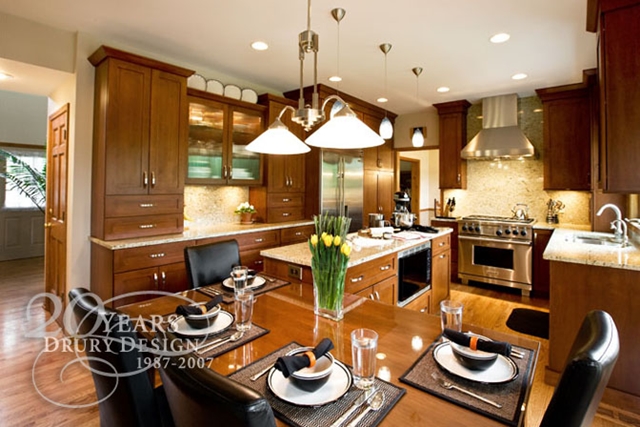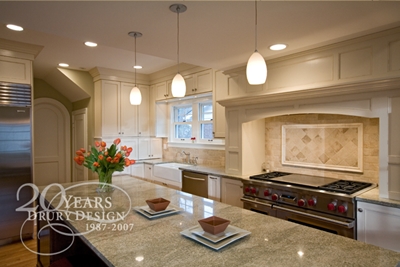 This kitchen by Drury Design shows various lighting options for all parts of a kitchen
This kitchen by Drury Design shows various lighting options for all parts of a kitchen
When it comes to lighting, kitchens can be a tricky room to tackle. In most homes, the kitchen is the hub of everything. You eat there, you prepare food there, you may watch TV there, have conversations there or your kids may do their homework there. Since so many different activities occur in your kitchen, it’s important to have the right lighting.
Kitchen lighting is tricky because you may need different types of lighting throughout. You may want a chandelier for ambiance, but you may also need direct lighting for preparing meals. In order to choose the right lighting for your kitchen, you need to consider all of the following.
1. Determine the most popular areas of your kitchen.
Actually take note of the places in your kitchen that are the most popular. Do you always prepare meals in the same location? Does your family always eat at the table, or do you also have an island or breakfast nook that is regularly used. Do your kids do homework in the kitchen? If so, where? Are you also in need of ambiance lighting?
One overhead light in your kitchen will usually not produce enough light to handle all of your kitchen’s necessities. If you always prepare food in the same place, you will want to ensure that you have accurate lighting. If you can install a light directly over the place you prepare food, you will have an easier time during preparation. You may want a simple can light or even a pendant or under cabinet light.
You also want to ensure that you have proper light over your kitchen table as well as an island or nook that also is regularly used. If your kids do homework at the table, you need to have a bright light fixture that produces an accurate amount of light needed to study. If you don’t want to eat under lighting that feels like the sun, you may want to opt for a light fixture that allows you to dim it. This way, your kids can have it bright while studying and you can turn it down during dinner.
If you do a lot of preparation on your countertops, of if you’re simply looking for some ambiance, you may want to install under cabinet lighting. This will help you get accurate lighting for tasks that are done on the countertops, and under cabinet lights serve as great ambiance if they are the only lights on in the kitchen.
If you have a large kitchen, you may need to invest in more than one overhead light fixture, or you may want to use a longer light fixture that spreads over a longer length and has adjustable bulbs that can be faced in different directions. This way, you can ensure that lighting is hitting all of your most popular places throughout your kitchen.
2. Stick with one color.
 If you need multiple fixtures throughout your kitchen, stick with one color scheme—and one color scheme that matches. For example, if you have brushed nickel handles on your cabinets, you may want to stick with brushed nickel light fixtures. This will ensure that your light fixtures match your current decor, and it will make them pop out by complementing your handles.
If you need multiple fixtures throughout your kitchen, stick with one color scheme—and one color scheme that matches. For example, if you have brushed nickel handles on your cabinets, you may want to stick with brushed nickel light fixtures. This will ensure that your light fixtures match your current decor, and it will make them pop out by complementing your handles.
Your light fixtures will always look best when they match. Don’t have one brushed nickel fixture and one oil rubbed bronze fixture. They will look mismatched and out of place. Most companies make an array of different fixtures that have the same style, so if you’re in need of a regular kitchen light and a chandelier, you can find complementary fixtures for your specific needs.
3. If you’re unsure, go simple.

A simple light fixture has the ability to match both contemporary and traditional designs. If you’re having trouble deciding which style of light you like or which colors to choose from, it’s always best to stick with something more basic. This way, it will match your decor, and you will be able to keep it if you change the style of your kitchen.
As long as you have a good understanding of the lighting you need and if you match your light fixtures with your current decor, choosing a light fixture for your kitchen will not be that difficult. Make sure it’s something you like, and make sure you know which type of bulbs it uses. Some newer light fixtures only take lower watt bulbs, and if you’re in need of a bright light, it may not be the one for you.
Abby Forester lives in Chicago and loves to write in her spare time. Abby enjoys working in the kitchen and recently got her cabinets remodeled by the Drury cabinet company.

Leave a Reply